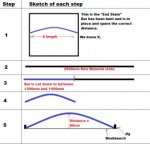Good morning everyone,
I am a first time poster - so I hope that I have followed the rules correctly because I am not sure what type of maths question this is, but here goes.
I work in a manufacturing facility that processes metal and creates an end product for use on vehicles.
Here is background:
The bar is now bent and ready to use.
Constants we know
1) We know the X Distance it must span, once bent.
2) We know the height the arc should be, measured in a flat position in the jig.
My Question:
1) How do we workout what size to cut the bar in the first instance (at step 3), so that it factoring in the bending process we end up with the correct X Span length?
Here is a drawing:

NOTE: Currently we have just used trial and error to find the size. E.g we would cut different lengths in step 3, and bend them and see if they fit until we got it right.
When you bend it the length gets shorter.
A calculation to solve this problem would be fantastic!
Thanks in advance,
Jesse
I am a first time poster - so I hope that I have followed the rules correctly because I am not sure what type of maths question this is, but here goes.
I work in a manufacturing facility that processes metal and creates an end product for use on vehicles.
Here is background:
- We have a Bar that must span X Length.
- That bar arrives as a completely straight (180 degree) form.
- The bar comes in lengths of 2900mm , and is cut down by our operator to suit each model of vehicle. Most sizes range from 1300-1400mm.
- Once the bar has been cut to size, the bar goes through a bending machine which creates an "arc" shape out of the bar.
- The operator then places the bar into a jig and pushes the centre of the bar down until the "arc" measures a distance of 88cm from the base of the table to the bottom of the arc.
The bar is now bent and ready to use.
Constants we know
1) We know the X Distance it must span, once bent.
2) We know the height the arc should be, measured in a flat position in the jig.
My Question:
1) How do we workout what size to cut the bar in the first instance (at step 3), so that it factoring in the bending process we end up with the correct X Span length?
Here is a drawing:

NOTE: Currently we have just used trial and error to find the size. E.g we would cut different lengths in step 3, and bend them and see if they fit until we got it right.
When you bend it the length gets shorter.
A calculation to solve this problem would be fantastic!
Thanks in advance,
Jesse
